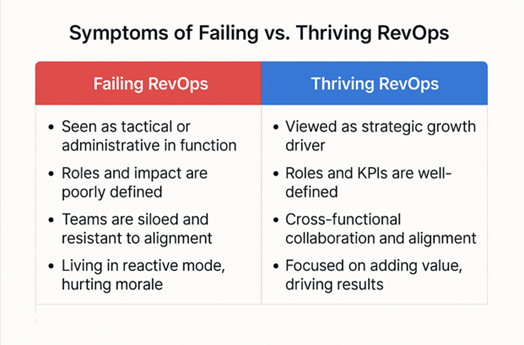RevOps is gaining traction as a strategic function, yet many companies still hesitate to implement it or see their initiatives stall before they gain traction. Why? The reasons go beyond budget or headcount. It often comes down to mindset, structure, and timing.
Lack of Executive Buy-In
RevOps touches every aspect of the revenue engine—sales, marketing, customer success, and finance. RevOps can not drive the systemic change it is designed for without executive alignment and sponsorship. When leadership sees RevOps as a tactical or support function, it lacks the authority and visibility to succeed.
💡 Tip: Frame RevOps as a growth enabler, not a cost center. Show how it can improve forecasting, accelerate pipeline velocity, and reduce CAC
Misunderstanding of What RevOps Is
Some organizations think RevOps is just a glorified admin role—managing Salesforce, building dashboards, or handling tech stack tickets. That’s like hiring a CFO and asking them to process payroll.
RevOps is about strategy, enablement, and accountability across the revenue funnel. When the role is poorly scoped or misaligned, it inevitably underdelivers.
🔍 RevOps is not just ops—it’s cross-functional orchestration with a mandate to optimize the entire GTM system.
Siloed Teams Resist Integration
Sales want autonomy. Marketing protects its attribution models. CS manages its data. If departments are territorial or KPI-driven in isolation, RevOps will face friction—or worse, passive resistance.
You can’t optimize revenue holistically when data, tech, and goals are fragmented.
🔄 RevOps works best when teams align around shared metrics: revenue growth, retention, and efficiency—not just leads or closed deals.
No Clear Charter or Measurable Goals
Without a clear charter, RevOps teams can get stuck in reactive mode—constantly responding to requests without delivering strategic value. It’s a fast track to burnout and perceived ineffectiveness.
A successful RevOps function has:
- A defined scope
- Key metrics (e.g., pipeline conversion, forecast accuracy)
- Executive support to prioritize cross-functional projects
Technology Overload or Underinvestment
Some companies launch RevOps as a bandaid to fix a bloated or broken tech stack. Others underfund it, expecting transformation without tools or data access—neither works.
The right RevOps leader can consolidate tools, streamline workflows, and drive adoption—but only if they can make the change.
Hired Too Early or Too Late
If RevOps is hired before data integrity, process maturity, or GTM alignment, they spend time fixing foundational issues instead of driving impact. If hired too late, they inherit chaos and skepticism.
🕰️ RevOps must be brought in at the right inflection point—typically when the GTM function becomes too complex to run without operational alignment.
Final Thoughts
RevOps is not a magic fix—but when implemented with the right vision, structure, and timing, it becomes a multiplier. Companies that get it right create a single source of truth, speed up decision-making and unlock scalable revenue growth.
Those that do not? They either delay adoption or launch it without the support and clarity it needs to succeed!


Leave a Reply